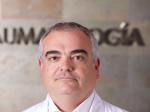The lumbar spine consists of five vertebrae whose shape and size are designed to withstand most of the body weight. It has more a range of motion than the thoracic spine, but less than the cervical. The main pathologies in this area include:
Lumbago
It is a lower back pain that lasts over time and can sometimes be accompanied by sciatica. The most common cause is often the degeneration of any component (vertebra, disc and facets) of the five that make up the lumbar spine. Excess of weight, lack of abdominal muscles and posture habits can aggravate the process. The treatment is stabilization (belt, corset), isometric exercises, postural hygiene, analgesics and muscle relaxants, rehabilitation treatment with currents and heat sources and even anaesthetic and corticosteroid infiltrations.
lumbar disc herniation
Between the vertebrae there are intervertebral discs that have, among others, the function of cushioning and distributing the load. Anatomically, the inside of the disc is formed by the nucleus pulposus, elastic and water-rich. The outside is formed by the annulus fibrous, which covers the core. If you break any of the fibers forming the ring, the core can move (discal protusion) or break. This is a disc herniation, which causes symptoms by compression of the nerve roots. The herniation usually results from degeneration of the fibrous ring. The patient reports back pain and restriction of movement, sciatic pain and tingling sensation. Treatment is usually conservative, except in extremely severe cases where there may be paralysis of the involved nerve. During the first days it is necessary to rest and an analgesic and anti-inflammatory therapy is applied. In six weeks, the recovery is notable in 80% of the cases.
Lumbar spinal stenosis
It is a condition consisting of the narrowing of the lumbar canal. In the center of each vertebra there is a hole. As there is a vertebra after another, a tube is formed through which nerve roots pass. Over the years, due to a degenerative process, this channel can get narrowed, resulting in a spinal stenosis. The patient complains of back pain and walking difficulty. Due to the slow progression of the disease when the crisis are more often, the only solution is surgery.


